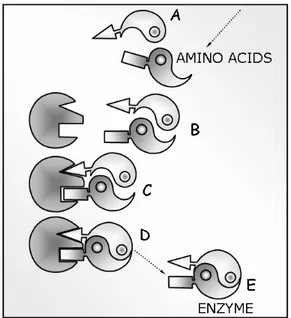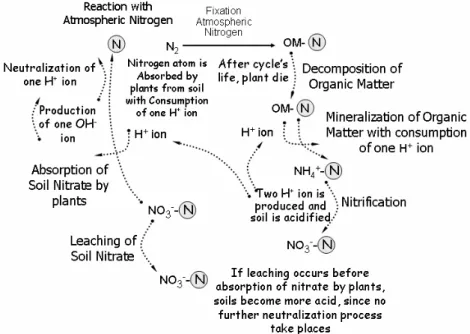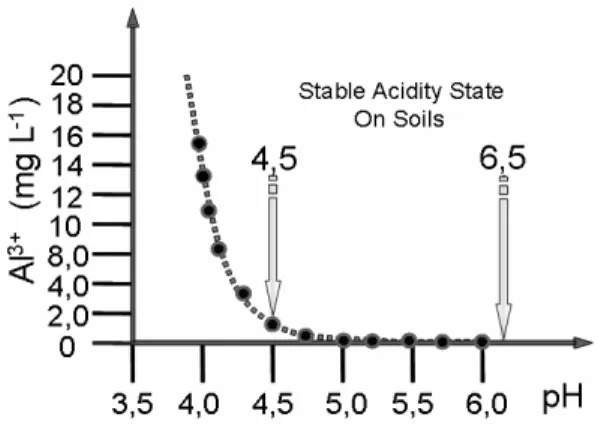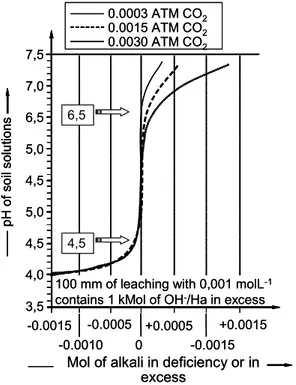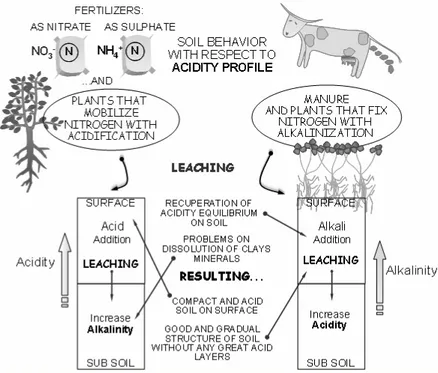www.scielo.br/aabc
The Trofobiose Theory and organic agriculture: the active
mobilization of nutrients and the use of rock powder
as a tool for sustainability
WAGNER L. POLITO
Instituto de Química de São Carlos, USP, Caixa Postal 780, 13560-970 São Carlos, SP, Brasil
Manuscript received on September 29, 2005; accepted for publication on March 13, 2006; presented byOTHONH. LEONARDOS
ABSTRACT
The primary objective of the present paper is to link some relevant concepts on the use of ecological agri-cultural practices to the production of food crops. In a special topic the Trofobiose Theory, as well as the principle of Active Dissolution of Rocks are considered as important tools in improving the sustainability of Organic, Biodynamic and Process Agricultures.
Key words:sustainability, trofobiose, vegetal nutrition, nutritional equilibrium, agro-ecology, rock powders, mineral fertilizations, organic fertilization.
INTRODUCTION
DEFINITIONS ANDTERMINILOGY
Product agriculture
This type of agriculture is based only on calendar and product without any conditions imposed on the process domain. Product agriculture makes exten-sive use of soluble inorganic nutrients to replenish soil fertility and toxic substances to control plagues and diseases.
Process agriculture
Process agriculture is based on the application of the so called “correct” agricultural processes involv-ing orderly ecological procedures and techniques aimed at minimizing the use of soluble inorganic nutrients to replenish soil fertility. It also focuses on the soil/plant equilibrium and employs alterna-tive or even substitualterna-tive procedures to reduce the use
E-mail: politowl@iqsc.usp.br
of toxic substances in controlling plagues, diseases and viruses.
Organic and biodynamic agricultures
PRELIMINARYTOPICS: SOMECOMMENTS, PAPERS ANDNOTICES
THECHINA FOOD CHALLENGE
During the last decade, the Chinese government encouraged its farmers to migrate from traditional agricultural cultures especially rice to legumes and fruits cultivation which are more lucrative and pre-sent a better return on investment. Following this advice, a vast area of over 13 millions hectares, equivalent to the area of England, was converted to a huge horticultural and fruit production zone. However, the consequences of such drastic changes became apparent only years later. Five years after the change, the soil suffered drastic alterations and became sterilized due to an increase in soil acid-ity, the nitrogen content increased fourfold while the phosphorous content doubled. The result was the death of, microorganisms, especially bacteria, which help in plant growth. These microorgan-isms almost disappeared from the soil resulting in some plants showing deformed products. These facts were reported in international papers such as
“Environmental Geochemistry and Health” and New Scientist. The overall breakdown of food
pro-duction was more than 20% on grains – rice and corn with serious consequences on food supply to more than 1.2 million inhabitants. Agricultural re-searchers in the western hemisphere, after investi-gating the causes of these soil problems, concluded that no problem existed with the production of fruit and legumes. According to their findings, the real cause of the observed disequilibrium was thought to be theexcessive use of soluble fertilizerswhich
endangered the natural source of potable water. It is important to remark that the overall agricultural production of China is equivalent to twice that of the United States. However, China employs four times more fertilizer than the US(Ciência e Tec-nologia do Brasil – Pesquisa FAPESP, N◦
105, November, 2004).
FUNGIDISEASE ONCOCOA
Recently, Scarpari et al. 2005 reported their re-search findings on a fungi disease caused by
Crini-pelli perniciosawhich is known to cause severe
dev-astation of cocoa. Scarpari et al. pointed out some details on hormonal disequilibrium and theextra doses of nutrients as well as some others chem-icals defenses (liberation of 10 times more alka-loids– theobromine and caffeine as natural sources
of defense against this fungi disease then followed by thedegradation of proteinand the beginning of
apoptosis – the programmatic death of vegetal tis-sues as a means of isolating the infected tistis-sues.
COMMENTS
The abovementioned facts and findings give clear evidences of nutritional disequilibrium and explain how plants acquire fragilities and defenses against diseases through trophic effects. They also explain how nutritional problems in plants can have seri-ous consequences on food supply and how the Tro-fobiose Theory can help us understand nutritional equilibrium thus improving tools necessary to obtain better food crops based on agro ecological practices.
THETROFOBIOSETHEORY
The termTrofobiosecomes from the Greek: Trofo (Aliment) and Biose (Existence of Life). Accord-ing to this Theory, all vegetal organisms, food crop inclusive, become vulnerable to plague infestation (insects, acaroids) and diseases (fungi, bacterial infections and other diseases) when excess free amino-acids and glycosides reductor species are present in their metabolic system, a source of sys-tem disequilibrium which gives rise to a condition ofproteolysis. On proteolysis, a set ofprotein hy-drolysisreactions takes place with the subsequent
storage ofproteolysis productsin cellular vacuoles
(free amino-acid and glycosides reductor species). Any external interference on the metabolic system capable of stimulating thisproteins synthesis, be it
of –genetic,physiologic,climaticorderor due to the type of agricultural procedures employed, can
generateentomologic and phytopatologic resistan-ces of the vegetal organism.
agro-ecol-ogical approach to agricultural practices but how-ever, without any parallelism made with respect to the ideas published by Steiner (originally pub-lished in 1924 and after in 1993) who, before then, had focused mainly on the principles of Organic and Biodynamic Agricultural Approaches.
Basically, Chaboussou´s theory was developed based on recursive methods cited in literature, and among his postulates, his text in which he gave several definitions and his terminology – or general glossary – emphasized, according to Chaboussou 1987:
...“In vegetal pathology, like in human or ani-mal pathology, an “iatrotogenic disease” is any kind of infection developed by the moderate or abusive use of any drug or aggressive substance. In veg-etals, the use of toxic and poisonous substances is the main cause of general plant vulnerability. Fre-quently, on the other hand, the authors mention the
“biologic disequilibrium”coupled to a subtle
pro-liferation of one or other plague just few days after a defensive or a phytosanitary treatment. For exam-ple, acaroids infestations can occur after a series of treatments with fungicides as well as insecticides”. After carrying out repercussion analysis on the influence of different agricultural practices such as replenishing of nutrients on plants resistance, Du-frénoy 1936 concluded that: “what actually chan-ges in vegetal cellules is the overall concentration of certain substances. These substances are stored in the form of vacuolar solutions as mineral salts species and/or carboxylic organic acids absorbed from the external environment under a non favor-able condition and to be later metabolized by the plant”. Dufrénoy defined as “non favorable
condi-tions” the inhibitive effects caused by fertilization disequilibrium due to an excess of macro and mi-cro nutrients such as the classical N, P, K fertilizers andsmall amounts of elementsnow considered as
activators of enzymatic catalysis.
This plants sensitivity determinism proposed by Dufrénoy 1936 can be restated in other words
as“all adverse circumstances that lead to the for-mation of a new amount of cytoplasm, unpropitious
to the growth of vegetal tissues, thus resulting in the accumulation of soluble compounds such as protein fragments (free amino acids) and reductor sugars (monosaccharide species)”. The storage of these
soluble substances appears to create a favorable at-mosphere for the nutrition of parasitic microorgan-isms and consequently the induced decrease of plant resistance against parasite diseases. In other words, an understanding of the state of proteolysis in veg-etal tissues allows us to determine plant sensibility (or vulnerability) to attack by parasite. Nitrogenous organic compounds with high nutritional indices (such as free amino acid and amide) are formed es-pecially on growth ends during senescence period when protein dissociates to amino acids. The state-ment of proteolyses is predominant over the pro-tein synthesis (Kennedy 1958).
Tomiyama 1963 also points out: “an increase in protein concentration observed in resistant tis-sues”. According to this author,“the accumulation of amide, the increase in protein concentration and phenolic compounds together with an increase in respiration processes strongly all suggest that dis-located materials and their transport are related to the observed increase in the speed of metabolism in vegetal tissues resulting the vegetal showing an increase in resistance against attack by parasites”.
This entomologic resistance cannot however be at-tributed to any effects of toxic phenolic compounds, but is derived from the absence of soluble species of nutrients and the ease with which they are assim-ilated. The absence of soluble species of nutrients in itself results from the stimulation of protein syn-thesis followed by the production of phenolic mate-rial. This line of reasoning appears to fully justify the concept of the Trofobiose Theory which postu-lates that“all vital processes depend on the satisfac-tion of the necessities of living organisms, be them vegetals or animals”(Chaboussou 1987).
of the attacking parasite or microorganism in ques-tion. And this state is not determinate by the nature of the plant alone, but also by the content of soluble nutritional substances. In summary thereof, the pre-ceding statements lead us to conclude thatwithout any intoxicationof the plant, theparasite ultimately dies and does so byinanition only. This is
experi-mentally consistent evidence.
CONTROVERSIES
The above considerations are all relevant when dis-cussing Trofobiose. In fact, almost twenty years after Chaboussou exposed this theme, it is not still easy to scientifically prove or refute the Trofobiose theory. This has been due mainly to limitations of the overall universe since any attempt to prove or refute this theory must be based on real descriptions which must rely on instrumental measurements and analysis of physical, biological or chemical data obtained by using adequate transductions and a variety of signals or by sight and other sensorial organ. Another limitation is the fact that proteins synthesis in living organisms occurs essentially un-der dynamics conditions and any analysis using veg-etal fluids gives only a limited idea of equilibrium under static conditions making any measurements difficult since the flow of nutrients is disrupted on sample collection with the consequent interruption of the plant vital cycle. And this is the main reason for employing indetermination of conceptual order. One of the major ideas deeply rooted in the Trofobiose Theory (and quite a controversial one) is that this theory postulates an accumulation of free amino acid in cellular vacuoles. However, in his pioneering work, Chaboussou does not explain the tolerance or the acceptable upper limit values of amino acid content. Scheller 1999 later stated that these concentrations cannot be higher than the limit value of 2%. This limit is however observed to be low for practical measurements and hence the determination of protein nitrogen content and free amino acids at this level of concentration is difficult, making it very difficult to evaluate the real condi-tions of the nutritional equilibrium state. Inversely, it is also difficult to establish a vulnerability’ index
that measures the likelihood of infestation by dis-ease or plague (insects and acaroids).
Divergences also occur relative to the real na-ture of enzymatic system of microorganism which takes part in the process of decomposition. Para-sites, fungi and also bacteria or virus are designed to attack vegetal tissues only under certain condi-tions and do not act to destroy healthy tissues since their feeding is restrict to simple (and not complexes) substances. On detecting (by means of any kind of exudates from these fragile tissues) any vulnerable plant tissues, these species attack them and this ex-plains why vegetal tissues are less resistant under proteolysis conditions.
However, microorganisms are discrete in terms ofdigestive enzymes. Some of them (bacteria) are
mono enzymatic; fungi may have two or three di-gestive enzymes and insects are reported to have a maximal number of twelve enzymes. This is prob-ably the most vulnerability point of the Trofobiose Theory since knowledge of digestive enzymes of discrete microorganisms that take part in the pro-cess of decomposition of plants is not well under-stood. Detailed studies of digestive enzymes of parasites, fungi and also bacteria or virus currently available are not yet precise relative to numbers and in actions, especially in terms of his activation (micro elements).
to be orderly orientated (B). The enzymes shown in Figure 1 “are able to find the active sites thus helping free molecules to be correctly position for reaction (C). In this respect, the group formed acts as catalysts joining groups placed in the structure of the proteins (D), acting as enzymes inside cel-lules (E). The enzymatic action depends on specific activators or micronutrients.
Fig. 1 – Enzymatic activities: Biosynthesis of enzymes by effects of micronutrients supply.
The natural resistance of plants is thus highly dependent on proteins which act as enzymes and
depends, to lesser extent on others kinds of pro-teins. In this case the enzymes are the true device to machine tools on cellular activities and plant defenses.
Although many questions and answers exist on food crop production, neither the beauty of the agricultural practice nor the volume of foodstuff produced (even under the most modern practices of genetic engineering) is relevant. This is because these attributes do not confer anynutritionalor bio-logical qualitiesto the resulting foodstuff inasmuch
as such quality can only be achieved through the conscientious use of agricultural practices. This makes the theme of food production an inexhausti-ble one needing a wider discussion.
Figure 2 shows various substances involved in biosynthesis. This representation makes special ref-erence to species which act as natural or intrinsic phyto/ferti protectors of plants.
The major part of these reactions is enzymatic biosynthesis and also includes synthesis of proteins. Many of these substances like polyphenolics (natu-ral flavonoids) are substances that increase the nat-ural resistance or the natnat-ural“self defense system”
of plants. Systematically, these substances can be detected and quantitatively analyzed in healthy and highly resistant organisms, but some doubts still re-main as to whethertheir synthesis would provide any kind of immunityandif so whether plants can exhi-bit such protective action when synthesized flavo-noids are applied to them.
Figure 2 shows also several cycles of the bio-synthesis of various compounds. Based on this fig-ure, one can attempt to explain the protective ac-tion of phyto and ferti protectors. This figure also emphasizes some other relevant chemical and bio-chemical aspects about the trophic (nutritional) ac-tion and the acac-tion of biotic and abiotic elicitor, es-pecially relative to the use of bio fertilizers, rock powder and the active mobilization of nutrients.
NUTRITIONALASPECTS ONDISEASES MANIFESTATION
CHEMICALFERTILIZATION ANDPRODUCTS AGRICULTURE
The technical progresses in food production achie-ved through Products Agriculture have been made clear in the book by Justus von Liebeg, in 1840: Der Chemie auf Agrikultur und Physiologie (Apud Scheller 2000). During the last 150 years, this ap-proach has always been used only to understand the Rule of Minimum and the Rule of Maximum on vegetal life. This is a complex theme related to many elements and involves the understanding of therole of nitrogen togetherwith other structural
Fig. 2 – Illustration of various nutrients involved in the process of biosynthesis and the participation of micronutrients in abiotic elicitation during the production of Fitoprotector by means of a series of enzymatic reactions.
Fig. 4 – Representative figure showing recursive variables and parameters which limit production.
Figure 4, presents limiting parameters for pro-duction for all kind of ambient considering changes that may take place on the way of the soil/plant system is treated and variable correlations of these parameters.
THENUTRIENTIONAL ANDAGROECOLOGICAL POINT OFVIEW
H.P. Rush and H. Müller are considered the pione-ers of Biological Organic Agriculture and the ba-sic concepts that guide the production of organic and biodynamic food crops (Scheller 2000) were first formulated by them. Scheller 2000 also men-tions Rush´s book on Soil Fertility (“Bodenfrucht Barkeit”) as a major contribution in the field of
organic and biodynamic agriculture. Nonetheless, Hans Müller was the first to apply the theoretical ideas of Rudolph Steiner (firstly published in 1924, Apud Scheller 2000), who is considered the real mentor of biodynamic and organic agricultural prac-tices. To understand the role that nutrients play on Organic and Biodynamic Agriculture, it becomes recommendable to consider sulfur as key element
and try to understand the role of this element when it combines with others constitutive elements such as carbon, nitrogen, oxygen and hydrogen. More
es-pecially, the importance and role of primary chemi-cal bonds and secondary bonds on constitutive com-pounds like proteins (meaning tertiary structures) have to be addressed. In fact, this line of approach is much more satisfactory in explaining various concepts in organic and biodynamic agricultures than any other approach based on nitrogen as key element.
The mechanics and mechanisms of the supply of nutrients are also a controversial issue in organic and biodynamic agricultures. To understand this phenomenon, the following basic aspects must be considered:
• Plants do not need only absorb dissolved soils nutrients following previous nutritional cycles, but they must also do tedious biological and functional work to make possible the use of fixed soils nutrients.
popula-tion of the rizosphere (microbial flora) which rises proportionately to the plant’s capability in synthesizing nutrients, or when the vegetal is able to transport light to chlorophyll carriers, thus “maintaining itself green in color”. Rush and Müller suggested that, “there is a great amount of nutrient stored in the form of strongly
fixed low solubility mineralswhich plants are un-able to get by mean of dissolution and hence plants try to dissolve these fixed nutrients by using rizo-sphere exudates”. In order to understand these
phe-nomena of plant intake of nutrient through rizo-sphere exudates, other basic aspects must come into play. These include the fact that:
• Plants use some assimilated nutrients (by their trophic selection and modifications) to carry exudates into the soil using special kinds of transport mechanisms by diffusion against the ascendant flow of xylem. Plants do this be-cause the exudates help in creating a symbiotic microorganism flora in the rizosphere, the bi-ological intensifications ending up as benefits to vegetal life.
• Among various types of bacteria present in the soil, plants always prefer a certain kind. The choice is done as a function of nutrients se-lection taken on the basis of symbiosis, and plant give preferences tonon alkalinizing
lac-tic acid formers. This phenomenon can also be proven by observing the population growth of the rizosphere flora which is expected to in-crease proportionately to the ability and capac-ity of plants to synthesize their selected nutri-ents and, as mentioned above, to the ability of the vegetal to transport light chlorophyll carri-ers or in other words, the ability to “stay green in color”.
In conclusion thereof, the supplies of inorga-nic synthetic and soluble nitrogen are the major causes of nutritional disequilibriumandfood qual-ity degradation. Hence, any replenishment of soil
nutrients must be done in such a way that plants in-teract with soil microorganisms. Figure 5 explains such an interaction.
Following the ideas of Rush and Müller,“plant and the soil microorganisms must transform the nu-trients supplied to be absorbed and assimilated”.
So, at least few soluble soil minerals must be considered as major sources of nutrients in the pro-duction of foodstuff and in extreme cases of real necessity, rocks powder can be applied in quantities equivalent to the needs for reposition”. It is thus worth stating that:
• Under conditions of severe necessity of potash (exhausted and poor soils), farmers are recom-mended to use K2SO4 while in severe cases
of phosphorus necessity, the recommendable choice is the use of rock powder.
• These resources should not, however, be con-sidered as “replenishment of nutrients”, but only as an extra input in extreme cases of long term failure of the process of biological mobi-lization of nutrients.
• Fertilizers derived from inorganic synthetic and soluble nitrogen are not recommended.
Under Agro-ecological practices, farmers are advised to take maximum advantage of stored nutrients deposited in the soil and hence any other non-renewable resources must be consid-ered only in conditions of emergency.
DIFFERENCES BETWEENPRODUCT-BASED AGRICULTURALPRACTICES ANDORGANIC AND BIODYNAMICAGRICULTUREBASED ON NUTRITIONALAPPROACHES
During the 1980s and 90s, the difference between
Product AgricultureandOrganic and Biodynamic Agricultureswith respect to representation of
Fig. 5 – Representation of a typical Agro Ecological Agricultural environment with biological intensification on replenishment of soil fertility and the action of exudates on active mobilization and dissolution of nutrients from low solubility agrominerals.
used by plantscan also bemobilized andusedby
plants to satisfy their necessities.
Following ideas of Prof. Dr. Edwin Scheller 2000, many of the relevant and controversial ques-tions on the topic were answered by the develop-ment of knowledge in the domain ofplant nutrition
and the phenomenon of Product Agricultural prac-tices. The answers to major doubts are related to theactive mobilization of nutrients, as follows:
1. With increasing productivity, different kinds
of cultures becomeindependents of the supply
of phosphorus and potassium.
2. The active mobilization of nutrients is now an unquestionable scientific fact that can be proven and implemented.
3. Anincrease in the rate of productivityresults
in an increase in the rates of substance mobi-lization and energy from the rizosphere.
4. Nitrogen has an important role on the active mobilization of nutrients and hence any in-crease in quality of food production depends on the source of nitrogen supply.
5. The fact that nitrogen supplies are stored in nitrogen compounds in humus substances strongly suggests that humus remainsthe prin-cipal source of the supply of nitrogenin the
vegetal kingdom.
6. The intensity offoodcultivationexerts marked
influences on the replenishment of nitrogen fromhumus: the more intense and
consorti-ated is the cultivation with biomass, the better the productivity. Hence, if better conditions of production of biomass are assured (nutrition or fertilization of biomass), the resulting quality of food is better. Figure 6 shows a typical pro-cess agricultural environment illustrating this comment.
Fig. 6 – Representation of a typical of Process Agricultural environment with chemical and biologic intensification during the replenishment of soil fertility.
ACTIVEDISSOLUTION ANDMOBILIZATION OF NUTRIENTS ANDSOILACIDITY
The term “Active Mobilization of Nutrients” by means ofdissolution of low solubility rock powder
involves advanced nutritional considerations and in itself needs a separate approach based on a consis-tent and broader atconsis-tention. Soil agrominerals oc-cur naturally in concentrations and forms that can be used as alternative fertilizers or amendments to replenish soil fertility. This is quiet interesting since farmers, instead of spending their saving on expen-sive and mainly using imported and water-soluble fertilizers, they could resort to alternative ways of accessing vital plants nutrients resources (van Straaten 2002).
Agrominerals include mainly limestone and dolomite, and also various soils made up of sili-cate rocks. The best agrominerals are: naturally occurring nitrate minerals in sizable deposits (salt-peter), phosphate rocks such as apatite compounds with P- and N- bearing complexes (Guano
Fig. 7 – A schematic representation of the Nitrogen cycle showing the reactions which occur due to an increase in H+ions concentration in the soil.
plants, and how the biological diversity and plant, tree pruning and leguminous mulches will be used on the cultivable soil as well as organic inputs in-cluding manures and the rizosphere exudates and its action on the active dissolution of nutrients from low soluble rocks. Since agrominerals do not occur in a form that is directly available to plants, but must be modified physically, chemically and biologically to become effective nutrients for the soil and plants, in order to apply fertilization by means of rock pow-der and organic material, one needs to know the pos-sibilities of any leaching of organic material and any transformations that can take place in organic ma-terial (manures, plant and tree pruning and legumi-nous mulches). This is of very fundamental impor-tance since the result of such transformations is the necessary nitrogen supplied in the form of nitrates or as ammonia salts to plant on rizosphere.
It is necessary to observe that the conditions for production in organic and biodynamic agricul-tural environments are more favorable than those in environments where replenishment of nutrients is carried out. However, this is only true if any
phe-nomenon that promotes rock dissolution specially powders containing low solubility species such as Mn (IV) and other low solubility materials in soils by mean of reactions which occur when ammonia is absorbed in rizosphere (acid process of exuda-tion) is guaranteed as shown in Figure 5. The un-derstanding of these phenomena together withsoil aciditymakes it a necessary requisite in
understand-ing the nitrogen cycle shown in Figure 7, and the state of acidity equilibrium in soil solutions (system containing aluminum silicates / CaCO3(s)/ CO2(g)/ H2O), and containing CO2 under different partial pressures and leaching and buffer effects which
The primary causes of acidity of soils that must be taken into account when considering the soil-plant-microbial flora system are: (1) Ni-trification; (2) Dissociation of Organic Acids from plants, tree pruning – the only organic input or or-ganic material (OM) by action of microorganisms (microflora) or leaching of likens; (3) Immobiliza-tion or volatilizaImmobiliza-tion of soil NH3; (4) Exudation of
H+ions by roots as a consequence of the
assimila-tion of more caassimila-tionic species than anionic ones by the rizosphere.
Fig. 8 – The mobilization and dissolution of aluminum from soils due to an increase in acidity induced by successive nitrogen cycles.
The active mobilization of nutrients and the supply of manure as a source of organic material result in nitrogen which compensates for any in-crease in acidity from organic acids and nitrate ions. This process called soil alkalinization is illustrated in Figure 9 and 10 and shows the following aspects:
1. Denitrification by means of the decomposition of NO3− by soil microflora,
2. Mineralization of nitrogen from organic mate-rial, OM in the soil.
3. Absorption of H+ ions from more acid soil’
OM by inorganic anions from less acid soil’ OM,
4. Oxidation of organic anions to CO2and water,
5. Exudation of HCO3− or OH− in response to the assimilation of more anions than cations,
6. Control of the leaching of OM and NO3−with better conditions of the stratification of soil structure without any large acid layer and no compact structure on the surface resulting from inputs of leguminous mulches and plant and tree pruning from biological degradation and assimilation by plants.
When plants that fix nitrogen (gramineae and leguminous) are cut, vegetal biomass can be formed by means of environmental and climatic action thus releasing soil Organic Material (OM) that is miner-alized to give NO3− or NH+4. To explain this phe-nomenon, the following aspects must be considered: (1) The overall OM in the soil ends up as organic
soil mass content of about 2.0% (in OM),
(2) From the decomposition of soil OM 90% of nitrogen replenished is obtained,
(3) The soil OM has 5.0% nitrogen in mass,
(4) 1.0% of which gives 10 to 14 kg of nitrogen per year.
On the question of the decomposition of soil OM, proteins and others nitrogen compounds present in the soil are converted to ammonium as shown in re-action (1) (ammonification). Subsequently, the
am-monium formed suffers a bacteriological conversion to give the nitrate ions (nitrification) as shown in
re-action (2).
MO of soil→NH+4 (1) NH+
4(aq) +2O2(g)→NO − 3(aq) +2H+
(aq)+H2O(l)
(2)
This last reaction depends on the presence of O2in the soil and can be inhibited by gramineae or
synthetic materials such as carboxy-methyl pyrazol (in E.U.A.).
Nitrate ions can be lost by leaching causing disequilibrium in acidity (increase of H+ in soils).
To explain the nitrate lost, three important sources of disequilibrium must be considered.
1. Denitrification of NO3−: Action of denitrifi-cation bacteria presents in the soil:
Fig. 9 – The Nitrogen cycle in the soil showing ammonification, nitrification and acidity at rizosphere resulting from an increase in H+which helps in the active dissolution of nutrients.
100 mm of leaching with 0,001 molL-1
contains 1 kMol of OH-/Ha in excess
-0.0015 -0.0010
-0.0005
-0.0015
+0.0005 +0.0015
0
Mol of alkali in deficiency or in excess
p
H
o
f
s
o
il
so
lu
ti
o
n
s
7,5
7,0
6,5
5,0
4,5
5,0
4,5
4,0
3,5 6,5
4,5
0.0003 ATM CO2 0.0015 ATM CO2 0.0030 ATM CO2
100 mm of leaching with 0,001 molL-1
contains 1 kMol of OH-/Ha in excess
-0.0015 -0.0010
-0.0005
-0.0015
+0.0005 +0.0015
0
Mol of alkali in deficiency or in excess
p
H
o
f
s
o
il
so
lu
ti
o
n
s
p
H
o
f
s
o
il
so
lu
ti
o
n
s
7,5
7,0
6,5
5,0
4,5
5,0
4,5
4,0
3,5 6,5
4,5
0.0003 ATM CO2 0.0015 ATM CO2 0.0030 ATM CO2
Fig. 11 – Effects of leaching on soils.
N2O→N2+1 2 O2 (Lost of gas to atmosphere)
(4)
2. Absorption by clay minerals,
3. Leaching.
The overall effects of leaching as well as other aspects affecting conditions of acidity and associ-ation of culture with biomass are showed on Fig-ure 11.
CONCLUSION
Linking the exposed relevant concepts about the use of some ecological practices to food production with special reference to Trofobiose Theory helps us understand the principle of Active Dissolution of Rocks as an important tool to improve sustainabil-ity of Organic, Biodynamic and Process Agricul-tures. This effectively can help in our understand-ing sustainable agriculture. The future well beunderstand-ing of the world’s population depends on linking the food challenges we face today to sustainable
devel-opment, food security and access to sufficient food by all.
RESUMO
O objetivo principal deste trabalho é estabelecer relação entre alguns conceitos relevantes sobre o uso de práticas agro-ecológicas na produção de alimentos. Em um tópico especial, a Teoria da Trofobiose bem como os princípios da Dissolução Ativa de Rochas são considerados como importantes ferramentas na implementação da sustenta-bilidade no processo de Agriculturas Orgânica e Biodi-nâmica.
Palavras-chave: sustentabilidade, trofobiose, nutrição vegetal, equilíbrio nutricional, agro-ecologia, pós-de-rocha, fertilização mineral, fertilização orgânica.
REFERENCES
CHABOUSSOU F. 1987. Plantas Doentes pelo uso de Agrotóxicos. L & PM Editores S/A, Porto Alegre, RS, Brasil, 253 p.
les plantes agricoles de grande culture les affections parasitaires et les maladies de carence. Ann Agron Suisse, p. 680–728.
KENNEDY JS. 1958. Physiological conditions of the host plant and susceptibility to aphid attack. Entomol Exp Applic 1: 50–65.
SCARPARI LM, METHARDT LW, POMELA AW, SCHIVIANATO MA, MAZZAFERA P, CASCARDO JMANDPEREIRAGAG. 2005. Biochemical chan-ge during the development of wiches’ broom: the most important disease of cocoa in Brazil caused byCrinipellis perniciosa. J Exp Botany 56 (413):
865–867.
SCHELLERE. 1999. Wissenschaftilche Grundlagen der Pflanzenernährrung in ökologischen Landbau. Ci-clo de palestras sobre nutrição avançada de plantas e vivicação do solo, IBD, Casa Some, Botucatu, SP, Brasil.
SCHELLER E. 2000. Fundamentos Científicos da Nu-trição Vegetal na Agricultura Ecológica (ABD). Editora Agroecológica, Campinas, SP, Brasil, 354 p. STEINER R. 1993. Fundamentos da Agricultura Bio-dinâmica. Editora Antroposófica, São Paulo, SP, Brasil, 235 p.
TOMIYMA K. 1963. Physiology and biochemistry of diseases resistance of Plants. Ann Rev Phytopathm 1: 295.
